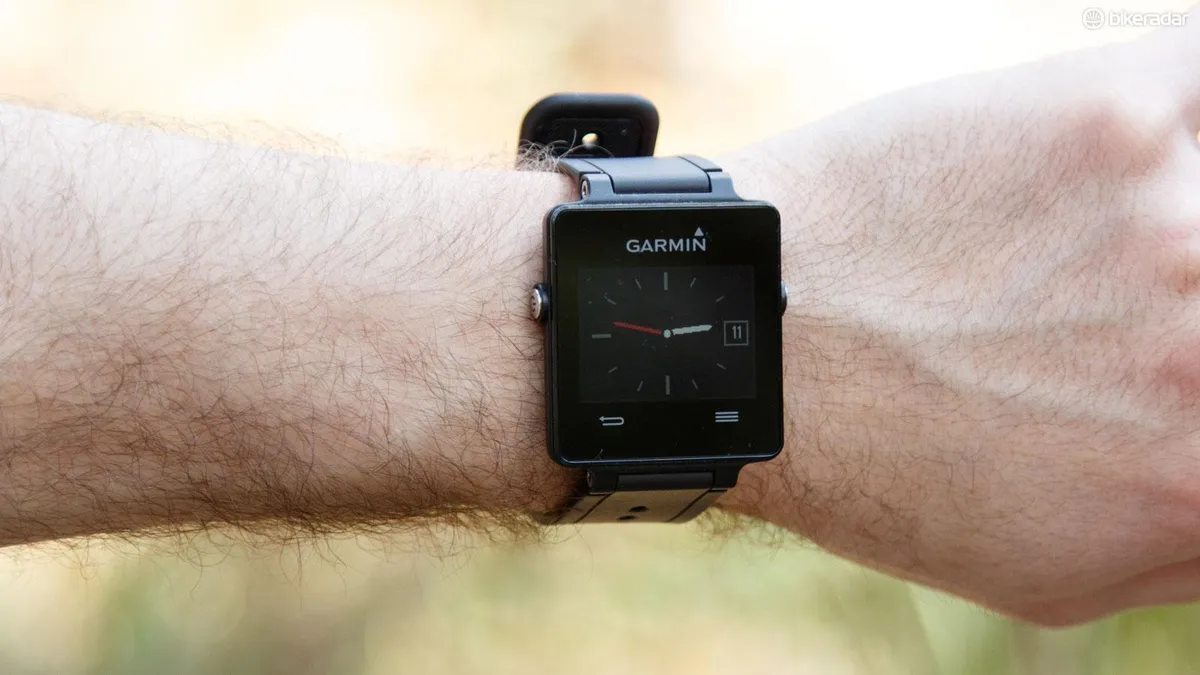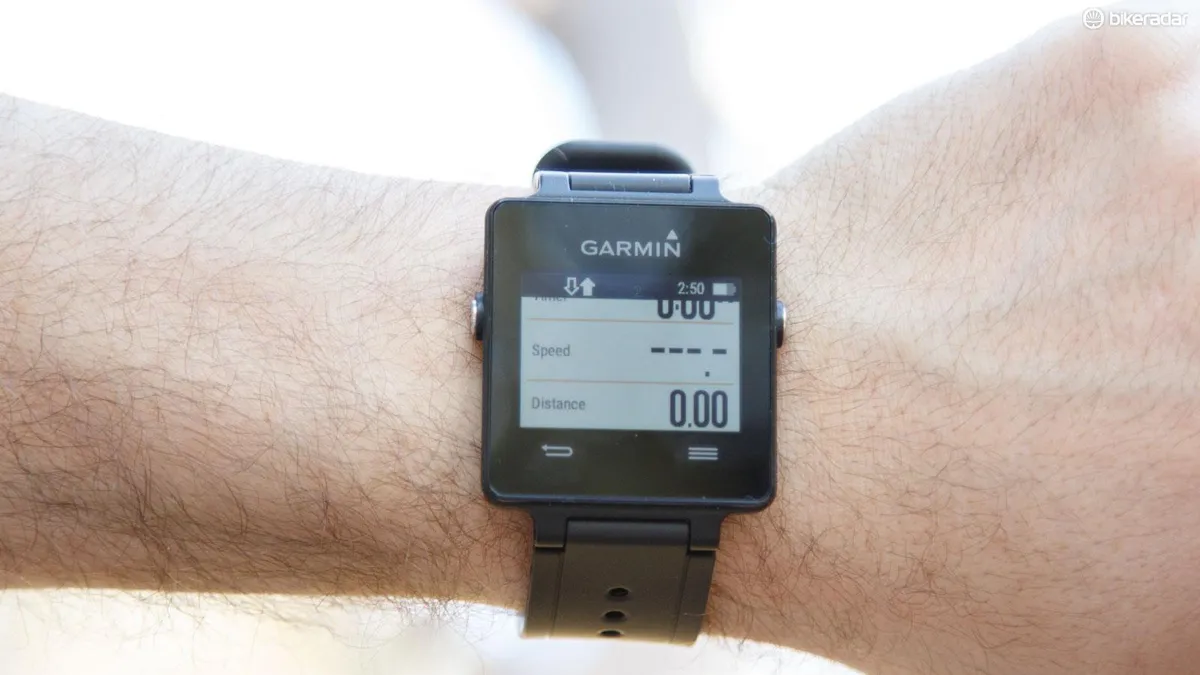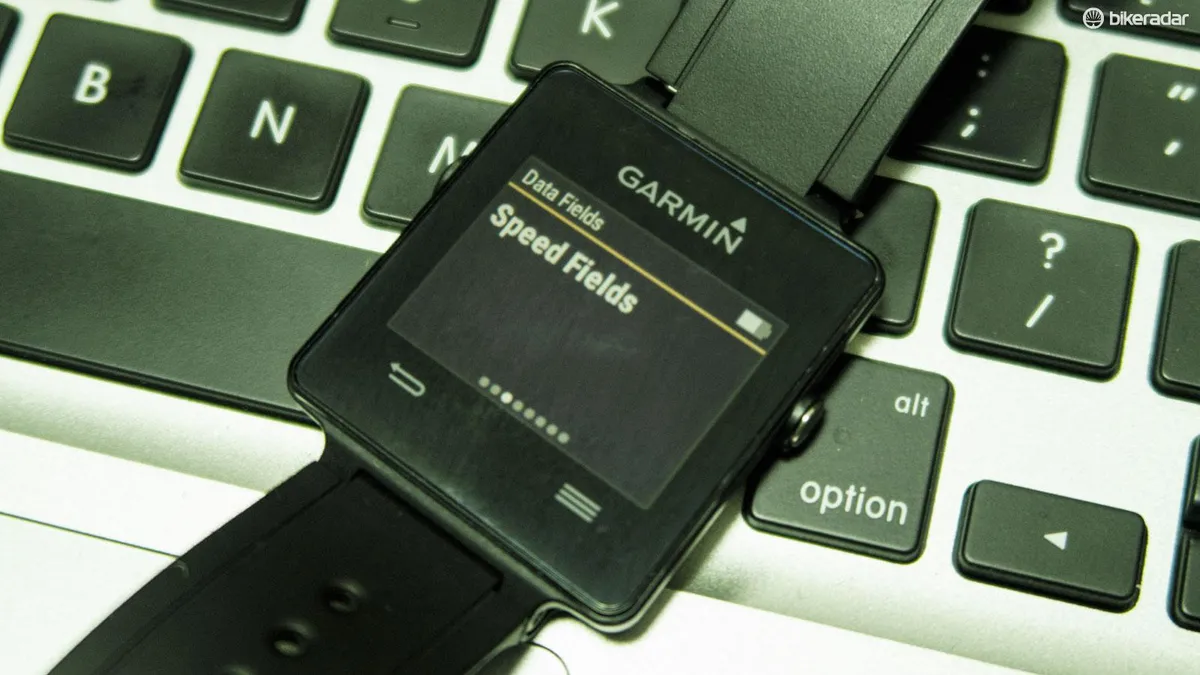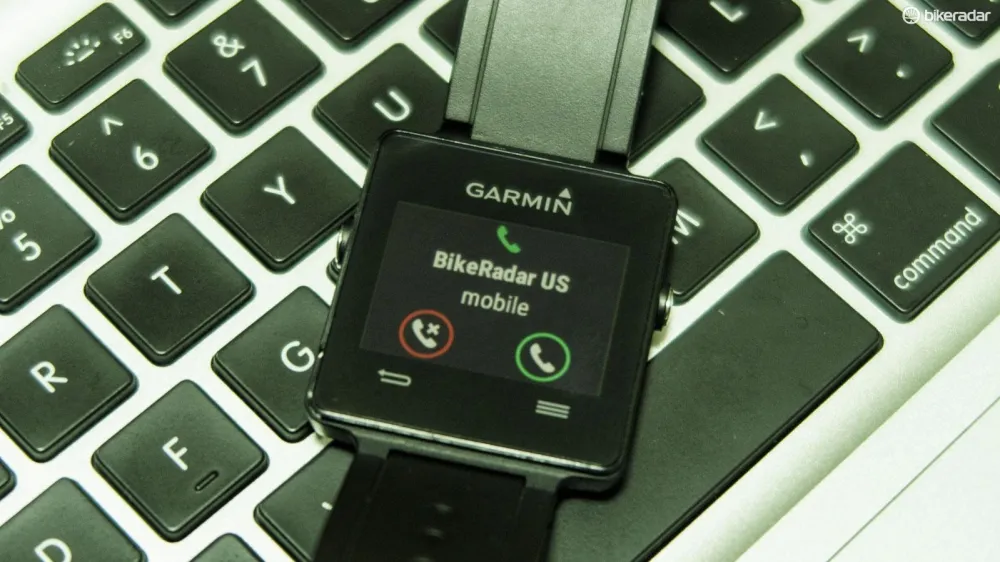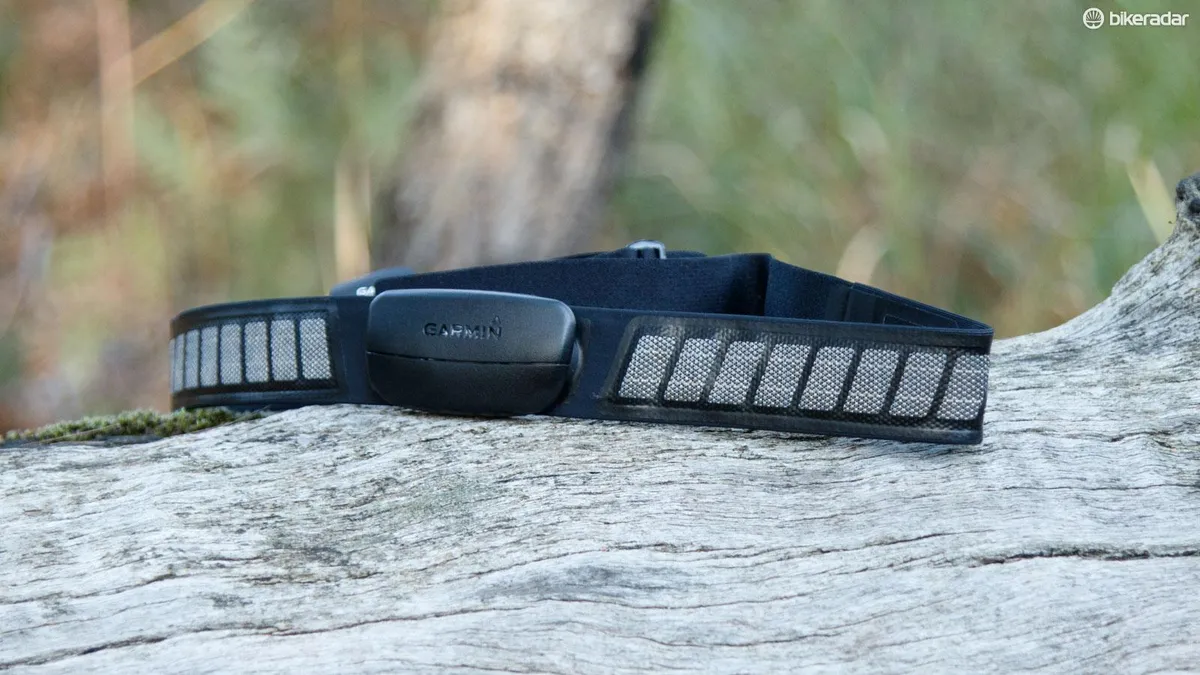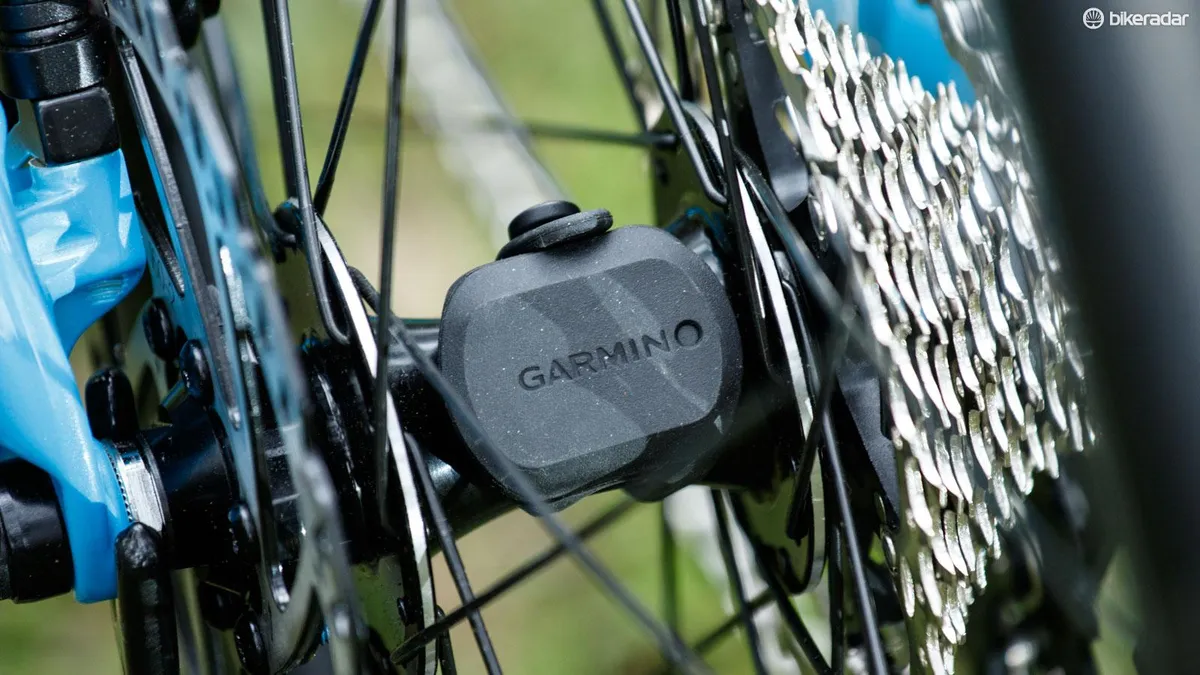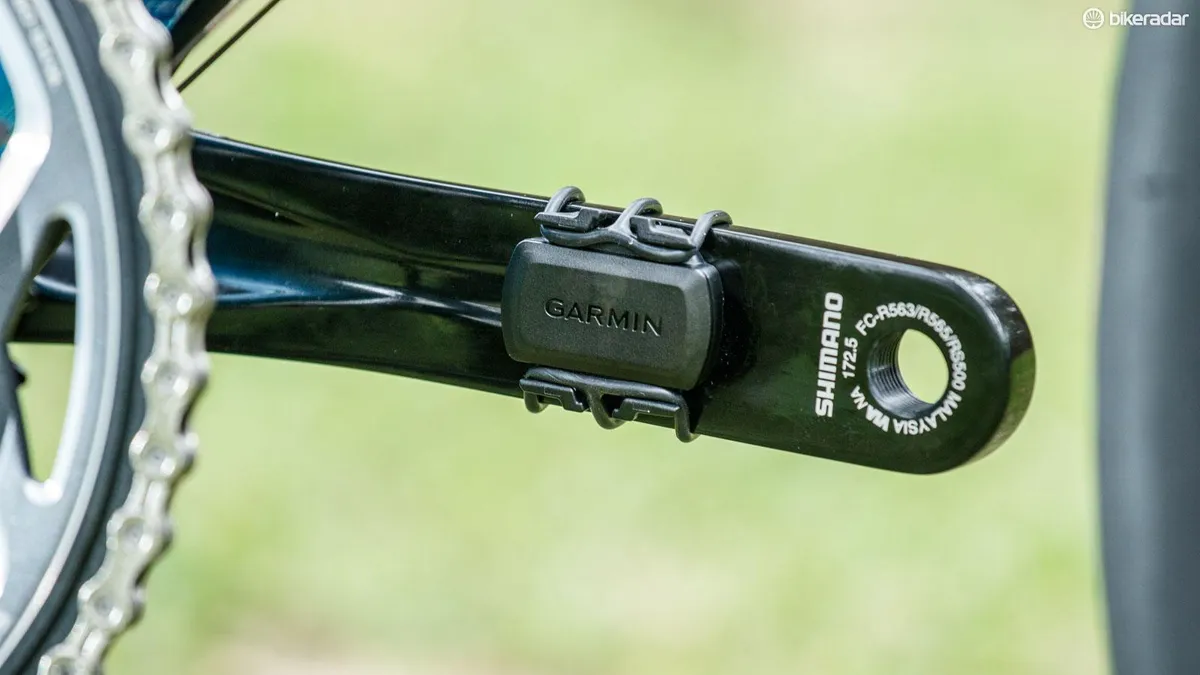It wasn't all that long ago that many of us wore heart-rate monitoring watches on our wrists when cycling. This lost popularity as the bike-specific GPS device took over, specifically the Garmin Edge.
Now we're seeing a resurgence of cycling watches, with many options pairing to your smartphone to relay basic information. The VivoActive from Garmin takes it a step further, and offers GPS connectivity independent of your mobile phone.
Sitting squarely in the market as a fitness-focused smart watch, the VivoActive has plenty to offer in everyday life; but we wanted to know what it can offer you, the cyclist.
The hardware
Sitting gently on the scales at 38g, the VivoActive is a minimalist wristwatch to wear all day. Of that 38g, 20g is the comfortable textured silicone rubber wrist strap – making the unit even the more impressive weight-wise.

8mm is rather slim by smartwatch standards
At 8mm thin, and under 44mm long, it’s a little slimmer and lighter than many other comparable smart watches, although a good share of this size is a border, and not the actual functional display, which measures a far smaller 28.6 x 20.7mm.
The colour touchscreen has a claimed resolution of 205 x 148 pixels. That’s nothing special when compared to the super-smartwatches from the likes of Samsung or Apple, but it’s perfectly adequate for reading text and using the simpler functions this device offers.
Depending on the light, the screen can read a little dull and needs the backlight in order to see the displayed data. In the sun and without sunglasses on, it’s generally pretty clear to read.
Operating the watch is achieved by using the touchscreen and the two buttons that each sit at the sides of the watch. The buttons are large enough to operate with gloves on, although during exercise they're only needed for turning on the backlight or pressing stop/start for the activity.
Swiping on screen can toggle multiple data screens, and the back button and drop down menu option are also on the touch screen.
The actual buttons come in handy again when you’re not moving. Here, the left is a backlight button that doubles as the power button. The right button is used to access the menu, where your desired sport, settings or even ‘find phone’ options can be found.
The VivoActive features its own GPS/GLONASS chip, accelerometer, Bluetooth 4.0 for phone connectivity, and ANT for use with compatible accessories; to measure heart rate, cadence and speed, for instance. That GPS chip is a key differentiator, as it means the watch can be used for recording sport activities independently of a phone.
Built for a variety of fitness activities, the VivoActive offers a ‘5 ATM’ waterproof rating, basically meaning it’s water tested to a depth of 50m (165ft). That’s easily enough to be worn in the shower, and to swim with too.
Aesthetically, the square VivoActive is certainly a sport watch and casual style isn’t its strong point. However, its slim profile and the fact that smartwatches in general are trending redeems it slightly.
In its stock rubber-strap form it’s not the sort of watch style you’d want to wear with cufflinks and polished leather shoes. That said, Garmin does offer leather straps to be screwed in place of the stock straps if you wish to dress it up.

The VivoActive needs its own dock (included) to charge, but that's certainly where the waterproofing comes in
Snapping into a magnetic USB charging dock, the watch features an in-built lithium-ion rechargeable battery. Using it as a general smartwatch without too much sport, we got approximately a week out of the battery.
That said, using the GPS in your cycling activities is likely to result in a battery life closer to just 10 hours. That’s approximately five hours less than something like the Garmin Edge 520, but a few more than something like an Apple Watch.
The stock rubber strap should fit a variety of wrist sizes. We measured the circumference of the available adjustment range from 13.5cm and up to 23cm.
In our months of testing, durability has been solid. We haven’t been delicate with the watch, and the face remains completely scuff-free. The only visible damage is the smallest of scratches off the side of the watch housing.
The firmware and related software
The nicest thing about modern phones, smartwatches and computers is that they're effectively a hardware shell, while the firmware is something that can change and update with time – assuming the company chooses to continue support.
Using the VivoActive is fairly easy. It’s not the very most intuitive device, but it’ll feel natural to those who have used Garmin fitness products previously. Those without previous experience will get the hang of the basic functions quickly, with less important stuff discovered over time.
Synced wirelessly with either a Bluetooth Smart (4.0) iPhone or Android through Garmin’s Connect app, the VivoActive communicates with your phone. It must go through this app, but thankfully phone battery life has been pretty stable with it running in the background.

Ring ring, buzz buzz
With it synced, the watch will alert you with a subtle buzz of incoming calls, text messages, emails and other push notifications. It will also tell you the weather forecast, your calendar and allow control of your phone’s music. Of course, all of this is optional and you can set it to do just what you want to know, or perhaps don’t want to know.
If you’re one to misplace your phone a lot, then the ‘Find my Phone’ feature on the watch may be helpful. Unfortunately, it needs Bluetooth connectivity - so your phone will need to be close.
Log into Garmin’s Connect IQ store and there are plenty of software apps, widgets and watch faces to wirelessly install to the watch. So while the watch may not offer an easily found battery life indicator or stylish clock face out of the box, there are free apps for that.
When we first got the VivoActive, we had regular issues of lost Bluetooth connection with an iPhone 6. Despite the phone app showing the VivoActive as connected, it just wouldn’t communicate until a reset of the watch brought it all back in sync.
Since then, it's gone under three firmware updates. While the effects of these haven’t been so major in use, we've seen subtle improvements in connection and data reliability. Recently, dropouts have been a rare occurrence.
The cyclists' take
For cycling, the VivoActive becomes a well-featured heart-rate monitor and bike computer, but on your wrist. It’s quite comfortable in use, and we never suffered from pinching or rubbing while gripping the bar (either mountain or road).
There are watch-to-handlebar mounts available from various manufacturers (including Garmin), but the fact that the VivoActive is on your wrist and always ready to pedal is part of the attraction here.
Being able to use the VivoActive as a standalone device without the need for a phone is a key difference to many other smartwatches. Here, the GPS works to record your distance, speed and even ascent ridden. For greater accuracy, the ANT compatibility means you can link in a cadence and/or a wheel speed sensor too.

Cadence and speed sensors can be used, although only ANT versions. Bluetooth sensors will not work
For this, we used Garmin’s pod sensors (£60 / US$70 / AU$90) that simply strap onto the left crank and rear hub. Unsurprisingly, cadence and wheel speed measurement with these tracks just like it does with a Garmin Edge device.
For heart rate, the VivoActive doesn’t offer the new integrated wristband-style monitoring, rather relying on a proven ANT chest strap. The VivoActive can be bought in a bundle with the premium heart rate strap, which is how our sample came (the bundle retails at £230 / $299 / AU$379).
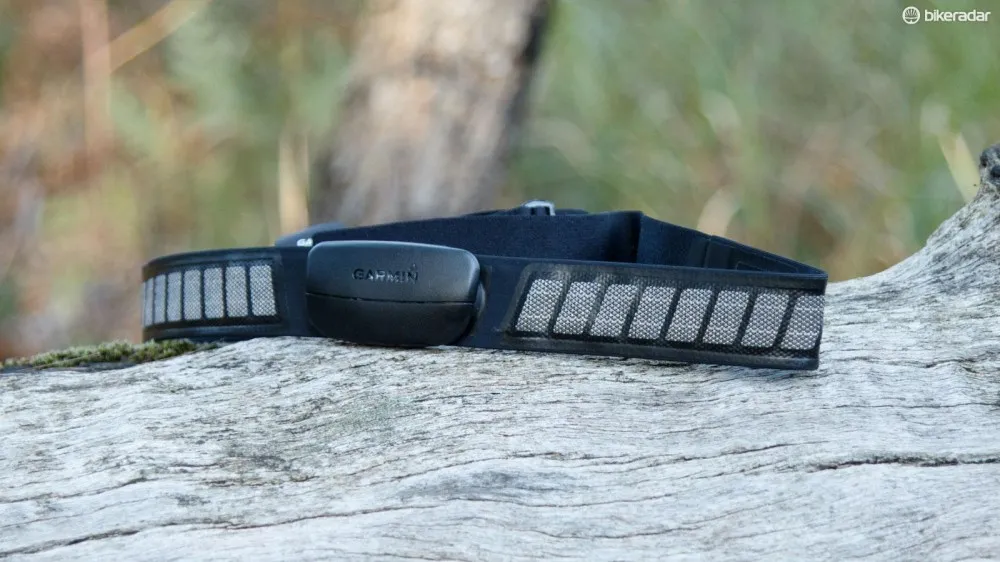
You'll need a ANT chest strap in order to receive heart-rate data
You can program your zones into the watch and be alerted when dropping out of a specific zone, although interval plans will need to be downloaded from the phone. Heart-rate accuracy proved inline with our trusty Garmin Edge 500, and the comfort of the strap is a big improvement over previous generation straps. The full strap weighs 47g and is machine washable with the sensor unclipped.
All this information can be configured to display in real-time where and how you want on the screen. If the stock settings aren’t enough, there are widgets available for free download to completely transform the layout of these data fields.
In this way, it does just about everything the new Garmin Edge 25 does, and more.
With power meters forever becoming more attainable in price, the watt-counting gadgets have become a widely popular training aid. This is where the VivoActive falls short, with absolutely no support for any power meters. If you’re committed to your training, then you may need to look for a more performance-focused training device than the VivoActive. Whether this may change in future with firmware updates is unknown, but it’s certainly currently the case.
Assuming you have the watch synced with your phone whilst riding, the call notifications are a handy thing. Knowing what the ringing is in your pocket (or pack), and being able to decline it with just one hand off the bars is a time saver, especially if you’re ever ‘on call’.
If you have all the gadgets, you can use the watch in basic control of a Garmin VIRB action camera. Sadly, this feature doesn’t apply to the more popular units from GoPro or Sony.
Finish the ride, and you can automatically upload this data to your phone through Garmin’s connect app. From here, you can elect for the data to be seamlessly pushed through to third parties, such as Strava.
What it also does
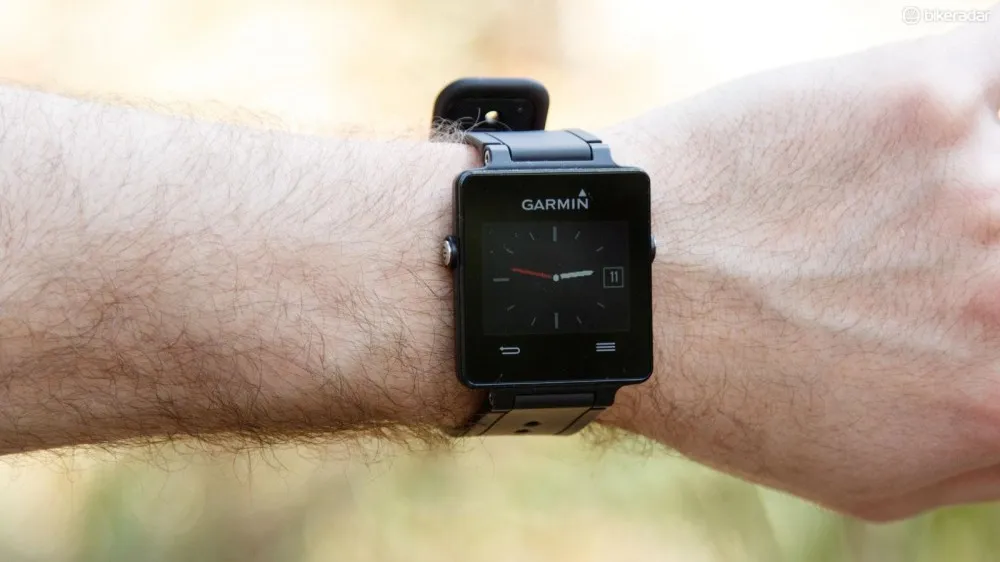
Don't forget, the VivoActive is still a watch designed to be worn all day
Step counters are hugely popular for those who don’t get as much exercise as most cyclists. With this, the in-built accelerator makes for a rather accurate step counter to track your daily foot mileage. The watch can also be set to remind you to move when you become lazy (as it did while writing this review).
When it’s time to kick up your feet, there’s a sleep tracker too. This provides some pretty interesting information into sleep patterns and those keen on training may be able to improve their recovery with this information. (Though it will of course only be available if you’re happy to wear the watch overnight.)
The VivoActive also offers a handful of sport-specific functions for those into running, swimming and even golf. While we didn’t hit the greens, we did do some running and it’s here that the VivoActive’s strengths are perhaps even more apparent than when cycling. The step (and leg speed) counting accelerometer, low weight, heart rate and GPS tracking are all ideal features for this.
And while you could probably have figured this out, this product is certainly appropriate if you like to participate in a triathlon or two.
Conclusion
The VivoActive is so much more than a cycling computer, though it does a great job at that too. It’s not the smartest watch out there, but it’s a fine example of a sport-focused design. If you live an active lifestyle, then the features offered are likely to prove useful and informative.
For us to score this even better, some form of power meter compatibility would have been great. We would love to see Garmin open up its sensor compatibility to include Bluetooth too. And then there’s the intermittent connection dropout with the phone – but this has vastly improved in over a few months of testing.
This isn’t a cheap watch; it sits right in the middle of pricing among other brand's smartwatches. However, we reckon it’s a fair price to pay for all that it does.

